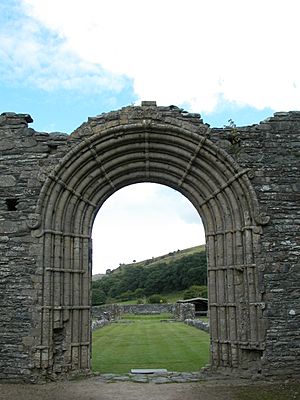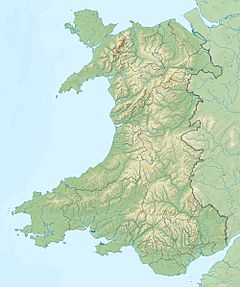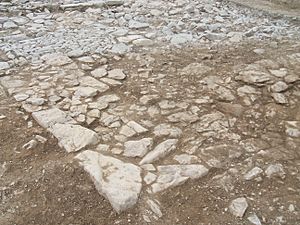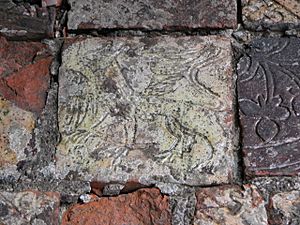Strata Florida Abbey facts for kids
Quick facts for kids Strata Florida Abbey |
|
|---|---|
|
Abaty Ystrad Fflur
|
|

Romanesque archway to the main nave at Strata Florida.
|
|
| Religion | |
| Affiliation | Catholicism, Cistercians |
| Year consecrated | 1201 |
| Location | |
| Location | Pontrhydfendigaid, Ceredigion, Wales |
| Architecture | |
| Architectural type | Monastery |
| Architectural style | Cistercian |
| Funded by | Rhys ap Gruffydd |
| Materials | Limestone |
| Website | |
| http://cadw.gov.wales/daysout/strata-florida-abbey/?lang=en | |
Strata Florida Abbey, also known as Abaty Ystrad Fflur in Welsh, was once a Cistercian monastery. It is located near Pontrhydfendigaid in Ceredigion, Wales. The abbey was started in 1164.
The Cistercian monks were a religious group who lived a simple life. Many important Welsh princes from the House of Dinefwr were buried at Strata Florida. This shows how important the abbey was to the Welsh rulers of the time.
Contents
History of Strata Florida Abbey
How the Abbey Started
The monastery was founded in 1164 by a knight named Robert FitzStephen. In the 12th century, Cistercian monks from Whitland Abbey in Carmarthenshire began building a religious home. They chose a spot near the Afon Fflur river, which is where the abbey gets its name. This was a time when the Cistercian order was growing very quickly. The first building site is called Hen Fynachlog, meaning "the Old Monastery."
Around 1164, Rhys ap Gruffydd, a powerful Welsh prince, became a main supporter of Strata Florida Abbey. In 1184, he issued another document confirming his support. This made Strata Florida a key monastery for Deheubarth, a Welsh kingdom in the south. Many members of the Welsh royal House of Dinefwr were buried here. This includes 11 princes from the 12th and 13th centuries. The famous Welsh poet Dafydd ap Gwilym was also buried at the abbey.
The church at Strata Florida was officially opened in 1201.
The Abbey in Medieval Times
Strata Florida grew into a very important and powerful religious center. Around 1238, Prince Llywelyn ap Iorwerth held a special meeting at the abbey. During this meeting, he made other Welsh leaders agree that his son Dafydd ap Llywelyn would be his rightful successor.
The abbey owned many farms across Wales. These farms, called "granges," provided food and money for the monastery. A very important historical book about early Welsh history, called the Brut y Tywysogion, was written at Strata Florida.
In 1401, during the early years of Owain Glyndŵr's rebellion against English rule, King Henry IV took over Strata Florida Abbey. The monks were thought to support Glyndŵr, so they were forced to leave. The abbey was robbed, and King Henry IV turned it into a military base. He used it to plan attacks against Welsh rebel forces in the area.
By 1402, the Earl of Worcester held the Abbey for the English king. He had hundreds of soldiers, archers, and foot soldiers stationed there. The abbey continued to be used as a military base in 1407 and 1415. After the Glyndŵr rebellion ended, the monastery was given back to the Cistercian monks.
The Abbey is Closed Down
Starting in 1539, Henry VIII decided to close down many monasteries in England and Wales. This was part of a big change in the church. Strata Florida Abbey was closed in 1539 by church officials. The buildings and everything inside them were valued and then sold off.
The church and most of its other buildings were torn down. Their stones, roof tiles, and lead were used for other construction projects. However, the dining hall (refectory) and sleeping area (dormitory) were rebuilt. They became a house called Tŷ Abaty for local wealthy families. Over time, different families owned the property, including the Stedmans and the Powells. Much of the abbey's land was given to Thomas Cromwell, 1st Earl of Essex. He then sold it to Sir John Vaughan.
The current parish church of St. Mary, which is inside the old abbey graveyard, might have been built using stones from the original monastery.
What Happened After the Abbey Closed
After it was closed, Strata Florida Abbey was left to fall apart. People didn't pay much attention to the site until railways arrived in the late 1800s. Stephen Williams, a railway engineer, became interested in the ruins. He was surveying a possible railway route through the area.
Williams was a founder of the Cambrian Archaeological Association. He invited the group to visit the site in 1848. After this visit, the Association rented the abbey site. They wanted to make it better for the public to visit and learn about.
Stephen Williams became a leading expert on Cistercian archaeology. He was put in charge of digging up the site. Over several years, he removed a lot of dirt. This uncovered most of the ruins that you can still see today. The interest in the ruins brought many wealthy Victorians by train. The Strata Florida train station, a main stop on the Carmarthen Aberystwyth Line, was named after the Abbey.
In 1851, a book called Illustrated London Reading Book described the Abbey. It said that the remains of Strata Florida Abbey were very interesting. It was a grand place for learning, founded as early as 1164. The Cistercian monks became famous and owned a lot of land. They built a large library that held important Welsh records, poems, and family histories. The monks also wrote a valuable history of Wales. The book mentioned that Edward I burned the Abbey when he invaded Wales, but it was rebuilt in 1294.
The book also said that large woods once grew around Strata Florida. Its burial ground was huge, covering about 120 acres. Many important people from all over Wales were buried there, including the famous poet Dafydd ap Gwilym. Today, the churchyard is much smaller. However, lead coffins, likely belonging to important people, are still found. Only a few old box and yew trees remain from the lush greenery that once surrounded the Abbey. Of the main building, only an arch and part of a tall wall are left. A small church now stands inside the area, built with materials from the old Abbey.
Protecting the Abbey Today
The site was made a Scheduled Ancient Monument in 1919. This means it is a protected historical place. Today, Cadw, a Welsh government body, takes care of it. You can see various ruins there. The main entrance archway is the most complete part of the monastery that remains. Low walls show where the church and its six smaller chapels once stood. A modern roof protects an area where medieval floor tiles were found. Some of these tiles are on display in the small museum at the site. One famous tile shows a medieval gentleman looking at himself in a mirror.
The graveyard next to the Abbey ruins is still used for burials. There is a memorial to the Welsh language poet, Dafydd ap Gwilym, near an old yew tree. A stone memorial in the Chapter House remembers the princes buried at Strata Florida. This stone is a copy; the original is in the site's small museum.
Digging Up the Past: Archaeology
Scientists from the University of Wales, Trinity Saint David have used special equipment to survey the ground. They found several large structures underground. One of these is thought to be the gatehouse to the Abbey's inner areas. There is no clear proof of a kiln (a type of oven) that made tiles for the Abbey in the nearby woods.
Digs at the possible gatehouse have found many pieces of medieval pottery tiles. This suggests that the building might have also had a chapel, possibly above the entrance. The building was later used as a home and perhaps for farming. At some point, a large front was built over the original gateway road. This created more space between the two buildings on either side. The structure then fell apart and was lost.
Archaeologists have also found old field boundaries. They studied two channels, called leats, that might have increased water flow into a stream called Nant Glasffrwd. It is believed these channels were used to power a mill further downstream. Pieces of iron working waste were found within the monastery grounds. As of November 2019, the excavations at Strata Florida were still happening.
See also
- List of monastic houses in Wales
- List of Roman-to-modern scheduled monuments in Ceredigion
- Desert of Wales





